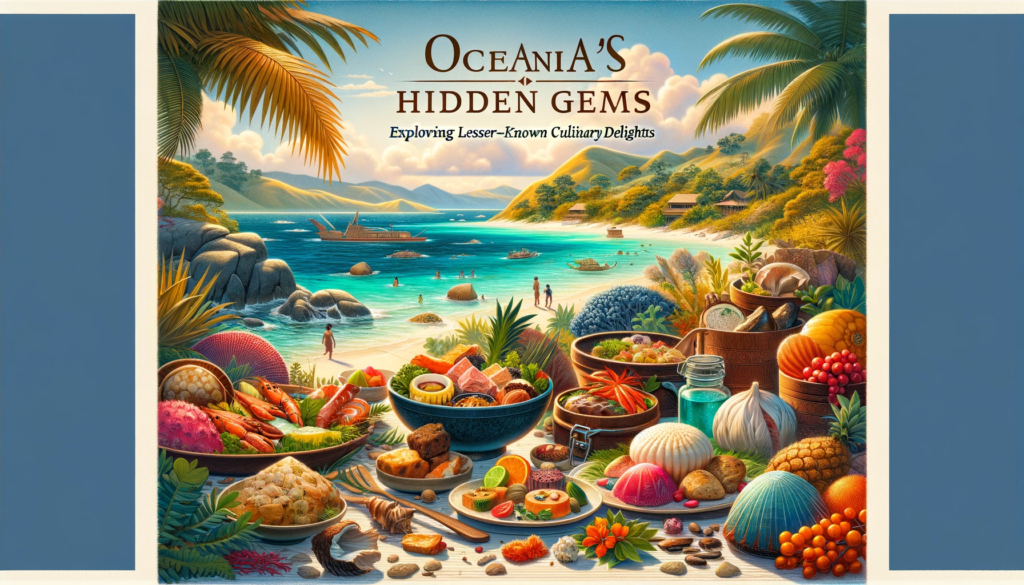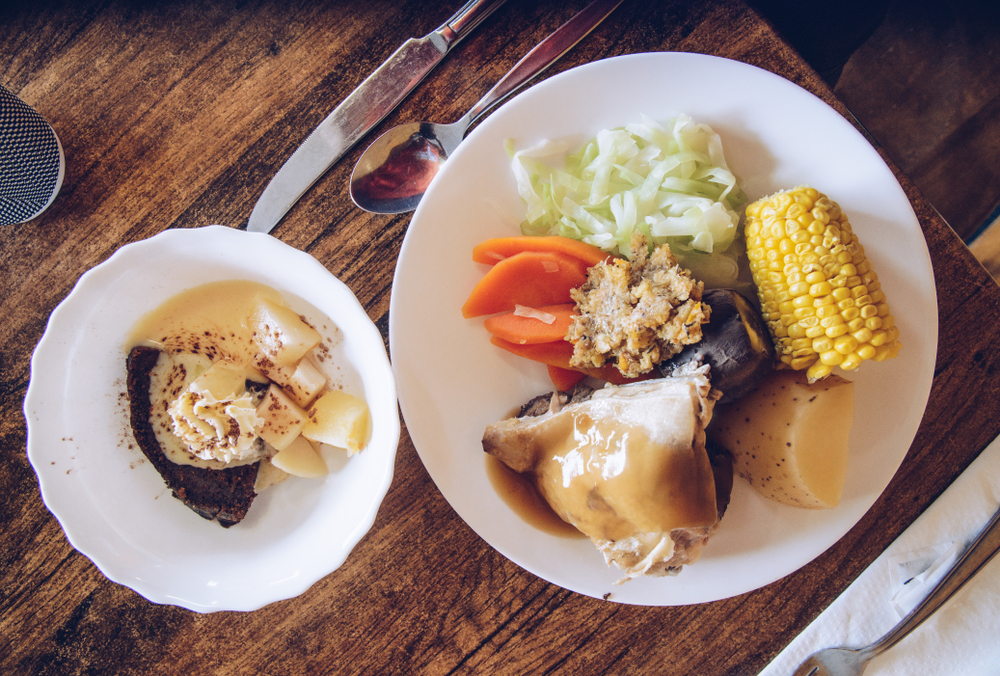Introduction to the Undiscovered Delicacies of Oceania
A Peek into Oceania’s Diverse and Rich Culinary Traditions
Oceania’s culinary landscape is as diverse as its myriad islands, each offering unique flavors and cooking traditions that are largely unfamiliar beyond local shores. From the coasts of Australia to the remote villages of Papua New Guinea, every locale boasts distinctive dishes that tell a story of the land and the sea. Delving into these rich culinary traditions reveals an intimate connection between local communities and their natural environments, reflecting a long history of adaptation and creativity. In this vibrant array, you will find an emphasis on freshness and locally sourced ingredients and a reverence for ancient preparations passed down through generations.
Unveiling Lesser-Known Dishes Across Oceania
New Zealand’s Maori Hangi – A Subterranean Feast
The traditional hangi is a Maori method of cooking that invokes the geothermal gifts of the New Zealand earth. A pit is dug, and heated rocks are placed inside. Succulent meats and vegetables, often wrapped in flax leaves, are lowered into this natural oven. The entire pit is covered, trapping heat and smoke to slow-cook the food for several hours. This process infuses the ingredients with a subtle smokiness and tenderizes them to perfection. Hangi is not just about the remarkable flavor; it’s a communal event that bonds friends and family and is integral to Maori celebrations and ceremonies.
Fiji’s Kokoda – Beyond the Common Ceviche
Fiji’s Kokoda (pronounced ko-kon-da) presents a tropical twist on the traditional ceviche, blending the freshness of the sea with citrus and coconut. This delightful dish is prepared by marinating raw fish, typically mahi-mahi or snapper, in lemon or lime juice, which cooks it through acidification. Once the fish turns opaque, it is mixed with coconut cream, onions, tomatoes, and sometimes peppers, offering a harmonious contrast of creaminess and tang. Kokoda embodies the essence of Fijian hospitality and is a must-try for those seeking a gustatory plunge into the archipelago’s marine bounty.
Solomon Islands’ Poi – A Unique Taro-Based Pudding
In the Solomon Islands, Poi stands out as a starch-rich, taro-based dish that bears a resemblance to a pudding but encapsulates a distinctive texture and tastes unique to Oceanian roots. The key ingredient, taro, is a staple across the Pacific, revered for its versatility. To make poi, taro roots are grated and combined with coconut milk, resulting in a smooth, sticky paste. Traditionally, it is fermented for a few days to attain a sour flavor, but it can also be enjoyed fresh with a dollop of sweet coconut cream. Poi is not just nourishment; it is a celebration of the region’s connection to taro cultivation that spans thousands of years.
Vanuatu’s Lap Lap – A Root Vegetable Specialty
Lap Lap is the national dish of Vanuatu, a hearty and fulfilling meal that underscores the Pacific Islanders’ affinity for root vegetables. This savory dish begins with yam, manioc, or taro, grated into a dough-like consistency. The mixture is combined with coconut cream and sometimes meat or fish, then wrapped in banana leaves and cooked in an underground oven akin to the Maori hangi. Once unwrapped, the lap lap reveals a fusion of flavors and textures, with the richness of the coconut harmonizing with the earthy staple crops. Its preparation is a communal activity, weaving culinary artistry and social bonds in one delicious package.
Tonga’s Ota Ika – A Fresh Take on Raw Fish
Ota Ika is Tonga’s answer to the raw fish dishes found across the Pacific, offering a uniquely vibrant and refreshing experience for the palate. Freshly caught fish, often tuna, is thinly sliced and left to marinate in a citrus juice until it becomes tender. The marinated fish is then tossed with a medley of diced vegetables, such as cucumbers, tomatoes, and onions, and dressed with a combination of coconut cream and chili for a creamy yet refreshing finish. Ota Ika is representative of Tonga’s culinary simplicity, where the quality and freshness of the ingredients speak volumes.

Unique Ingredients in Oceania’s Culinary Palette
Discovering Native Fruits, Vegetables, and Spices
The biodiversity of Oceania encompasses an array of native fruits, vegetables, and spices, many of which are seldom seen in other parts of the world. For instance, the breadfruit, with its starchy texture and versatility, is a cornerstone in many Oceanian dishes. Spices like kava, derived from a plant that also holds ceremonial importance, add a distinctive numbing spice to cuisine. Local markets throughout the islands are vibrant showcases of these exceptional products, providing glimpses into the region’s agricultural heritage and the integral role that these ingredients play in traditional diets and culinary practices.
Exotic Seafood Varieties of the Pacific Ocean
The vastness of the Pacific Ocean offers a seemingly endless supply of exotic seafood, a staple of Oceania’s diet. Among these are the reef-dwelling parrotfish, the rich and buttery wahoo, and the highly prized sea urchins, or ‘Kina,’ in Maori language. Beyond common species, the ocean’s depths provide delicacies like sea cucumber and trochus snails, which are integral to some local cuisines. The freshness of the catch is paramount in Oceania, where fish often go from the ocean to the table in a matter of hours, ensuring a culinary experience that is both authentic and deeply rooted in the region’s maritime culture.

The Influence of Traditional Cooking Methods
Ancient Techniques Still Used in Modern Cooking
Within Oceania’s cuisine, ancient cooking techniques are cherished and preserved, often coexisting with modern culinary practices. Earth ovens, like the Hawaiian imu or the Fijian lovo, are prime examples of food being slow-cooked underground and wrapped in leaves for a distinctive flavor. Smoking over open fires, stone grilling on hot rocks, and baking in bamboo cylinders are other age-old methods. These techniques showcase a sustainable approach to cooking, deeply rooted in an appreciation for nature and the minimalistic use of resources, mirroring the region’s ethos of living in harmony with the environment.
The Role of Earth Ovens and Open Flame Cooking
Using earth ovens and open-flame cooking in Oceania is not merely a culinary preference but a part of the cultural identity. Earth ovens, by their nature, create a communal ambiance, bringing people together to partake in the preparation and enjoyment of a meal. These methods impart a smokiness and tenderness to the food that modern appliances cannot replicate. Similarly, open-flame cooking is not just about grilling. It is an interactive experience involving careful tending of the fire, meant to instill patience and respect for the elemental force that transforms raw ingredients into nourishing feasts.
Fusion Foods: Blending Local Flavors with International Influences
How Global Cuisines Have Influenced Oceania’s Foods
The interchange of cultures through colonization, trade, and migration has deeply influenced Oceania’s food landscape, resulting in a fusion cuisine that harmoniously blends local flavors with international influences. Asian and European culinary traditions have intermingled with indigenous techniques and ingredients, creating distinctive dishes. For instance, Chinese-influenced rice dishes cooked with local spices, or French-inspired pastries incorporating tropical fruits, exemplify this culinary cross-pollination. This fusion adds depth and variety to Oceania’s cuisine, making it an exciting, evolving tapestry of flavors.
Contemporary Dishes That Showcase Culinary Fusion
In the ever-evolving world of Oceania’s cuisine, contemporary dishes that showcase culinary fusion are gaining popularity. Chefs across the region are creating innovative recipes that marry traditional Oceanian ingredients with modern international cooking techniques. Dishes such as taro-leaf risotto, chili-infused sashimi, and coconut milk cappuccinos exemplify how traditional elements are being reimagined to fit the palates of a global audience. This blend represents the dynamic nature of Oceania’s food culture, with its ability to adapt while honoring its roots.
Where to Find These Culinary Hidden Gems
Exploring Local Markets and Traditional Eateries
For those eager to embark on a culinary voyage through Oceania’s hidden gems, exploring local markets and traditional eateries is essential. These markets burst with fresh produce, vibrant spices, and artisanal goods, offering an authentic glimpse into the region’s food culture. Traditional eateries, often family-run, provide a warm and genuine dining experience, serving dishes steeped in generational knowledge and local folklore. Immersing oneself in these spaces allows for a deeper understanding of Oceanian cuisine beyond the surface-level offerings of tourist-centric restaurants.
Festivals and Events Featuring Authentic Oceanian Cuisine
Culinary festivals and local events are treasure troves for experiencing authentic Oceanian cuisine. Seasonal celebrations, harvest festivals, and food fairs offer an array of dishes prepared using traditional methods, often accompanied by storytelling, music, and dance. Participating in such events provides a platform to connect with the community, learn the stories behind the dishes, and enjoy the convivial atmosphere of shared meals. It’s an opportunity to witness firsthand how food is an integral part of Oceanian culture, embodying the spirit and history of its people.
Preserving Oceania’s Culinary Heritage
Efforts to Maintain Traditional Foodways
Preservation efforts of Oceania’s culinary heritage are critical in maintaining the region’s diverse foodways. Initiatives such as the documentation of ancient recipes, the revival of nearly forgotten techniques, and the cultivation of heirloom produce are being spearheaded by communities and organizations alike. Educational programs that teach the younger generation about traditional food preparations and the nutritional value of indigenous ingredients are fostering a renewed interest and appreciation for their gastronomic roots. These movements are crucial, not only for safeguarding culinary traditions but also for ensuring the sustainability of local food systems.
The Importance of Sustaining Indigenous Culinary Practices
The value of sustaining indigenous culinary practices in Oceania goes beyond preserving a cultural artifact; it is about maintaining a living link to the past. These practices provide insight into the sustainable use of land and sea resources, offer health benefits associated with traditional diets, and support food sovereignty. By prioritizing indigenous knowledge and techniques, communities can resist the homogenizing effects of globalization on diets and preserve the biodiversity of the local ecosystem. Embracing and promoting these practices is crucial to keeping Oceania’s culinary identity vibrant and intact for future generations.
